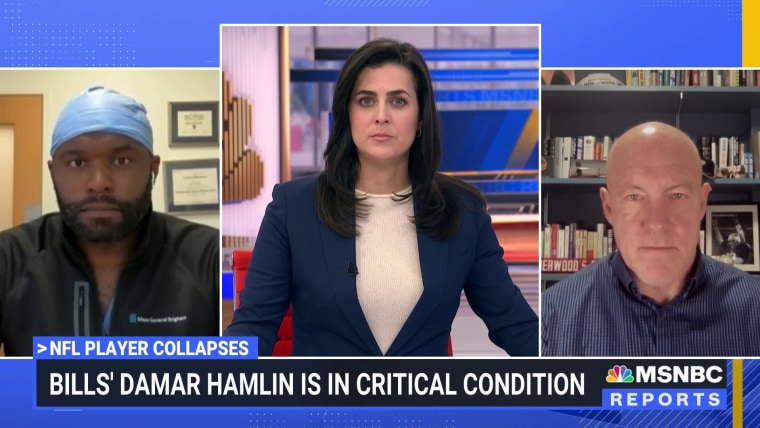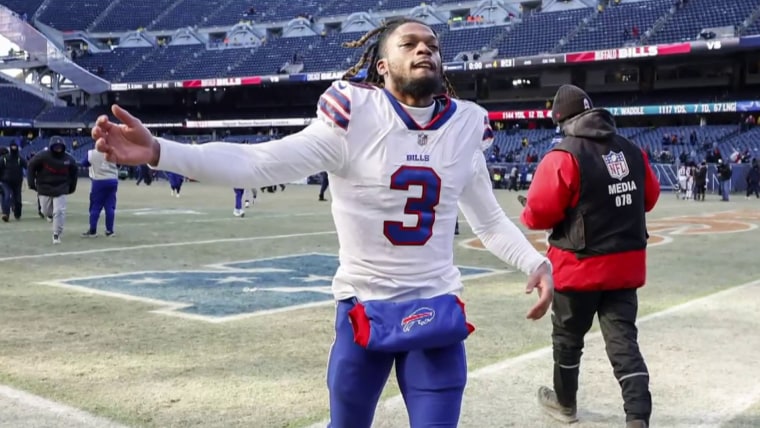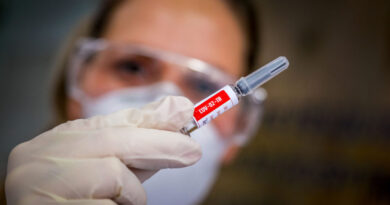How Damar Hamlin’s collapse became the latest anti-vaccine conspiracy theory
When Buffalo Bills safety Damar Hamlin went into cardiac arrest after colliding with another player Monday, people understandably cast about for explanations. My social media feed exploded with questions and hypotheses: Was it a traumatic injury to his aorta? Was it a heart attack? Unfortunately, in that space of shock and uncertainty, anti-vaccine activists were quick to insinuate a link to Covid vaccines, suggesting that there’s been a scourge of athletes “dropping suddenly.”
For those wielding an anti-vaccine rhetoric hammer, any emergency or sudden death related to sports has become a nail.
The narrative that there’s been a spike in athletes collapsing has been circulating for a while, despite being repeatedly debunked. The rumor likely started after the finding that there’s a real, but small, increased risk of myocarditis, or inflammation of the heart muscle, particularly among young men, after mRNA vaccines.
These rumors really took off in 2021 after Danish soccer player Christian Eriksen had a sudden cardiac arrest on the pitch. Purveyors of Covid disinformation speculated that Eriksen had had an adverse reaction to a Covid-19 vaccine — even though Eriksen had not been vaccinated at the time of his cardiac arrest.
For those wielding an anti-vaccine rhetoric hammer, any emergency or sudden death related to sports has become a nail. After soccer journalist Grant Wahl collapsed in Qatar while covering the World Cup, anti-vaccine propagandists were quick to insinuate that vaccines caused his death. The anti-vaccine rhetoric was so virulent that it prompted his wife, infectious disease specialist Dr. Céline Gounder, to say pointedly in a public statement, “His death was unrelated to vaccination status.” An autopsy determined a ruptured aortic aneurysm caused Wahl’s death.
Cases of myocarditis after Covid vaccines fortunately have been mild and tend to resolve rapidly. Medical experts believe it to be an unlikely cause of Hamlin’s collapse.
“Such an event is so, so low in the list of possibilities,” cardiologist Sandeep Jauhar, author of “Heart: A History,” told me. “Most, if not all, NFL players have been vaccinated. Why haven’t we seen more instances of this event among other players? They are using this poor man’s tragedy as fodder to spin a far-fetched theory.”
Sudden cardiac arrest during sports-related activity has been observed for hundreds of years. Though its occurrence is rare (fewer than 1 in 100,000 athletes per year), it occurs consistently enough that the American Heart Association recommends cardiac screening of athletes before they’re allowed to play competitive sports. There are well-established etiologies of cardiac arrest in otherwise healthy athletes, including undiagnosed structural heart disease (e.g., hypertrophic cardiomyopathy), congenitally abnormal coronary arteries, an entity called commotio cordis and cardiac conduction defects (e.g., long QT syndrome or Brugada syndrome).
Cases of myocarditis are many times more likely for patients who’ve become ill with Covid than for people who’ve received a Covid vaccine.
Hamlin’s collision with the player he tackled moments before his heart stopped stimulated discussion of commotio cordis, a phenomenon in which ventricular fibrillation — an irregular heart rhythm that prevents life-sustaining blood flow — is provoked by a blunt blow to the sternum. But what exactly caused his case remains to be seen.
Given the high incidence of Covid across the nation and the world, and its ability to affect the body so broadly, we will certainly see health consequences related to the disease, including among our sports-active children and young adults. In addition to the impact of acute illness on participation, long Covid has become an explicit concern for athletes, affecting their level of participation and their level of performance and necessitating the development of dedicated return-to-play guidelines. Cases of myocarditis and other cardiopulmonary conditions are many times more likely for patients who’ve become ill with Covid than for people who’ve received a Covid vaccine. While we wait to understand the scale of Covid impacts on athletes at all levels, vaccination remains an important means of keeping athletes healthy and active in sports.
There is certainly also work needed to better address the known reasons for cardiac arrest in young athletes. While screening programs reduce the incidence of sudden cardiac arrest among athletes, each of the underlying predisposing conditions mentioned above may elude standard athletic screening exams and electrocardiograms. Therefore, we need to put more effort toward preventing incidents from occurring in the first place, through modifications in how players block and tackle, and through ongoing improvements in protective athletic equipment. We can also vastly improve our public responses to cardiac arrest, by encouraging higher levels of bystander cardiopulmonary resuscitation (CPR) and higher availability and use of automatic external defibrillators (AEDs) to increase the likelihood of survival for athletes to whom this occurs.
Easy-to-use AEDs, such as the one used on Hamlin in the stadium, should be made as widely available as possible as well as accessible to the public. Phone apps such as PulsePoint display crowdsourced maps of AEDs in the area, including the exact location within a building where the lifesaving devices are. Community layperson CPR training has been made more accessible by the American Heart Association and the Red Cross. Many states now require students graduating from high school to have CPR training, but nine still do not, a missed opportunity to save more young lives.
Unfortunately, long cumulative experience with cardiac arrest among athletes playing competitive sports has allowed us to understand the likely culprits of this potentially deadly event. Anti-vaccine rhetoric should not distract us from legitimate avenues of inquiry about how we can give all levels of athletes the best chance to stay safe and healthy.




